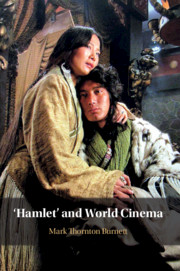Book contents
- ‘Hamlet’ and World Cinema
- ‘Hamlet’ and World Cinema
- Copyright page
- Dedication
- Contents
- Figures
- Acknowledgements
- A note on texts and titles
- Introduction
- Chapter One Hamlet, Cinema and the Histories of Western Europe
- Chapter Two Thematizing Place: Hamlet, Cinema and Africa
- Chapter Three Hamlet and the Moment of Brazilian Cinema
- Chapter Four Pairing the Cinematic Prince: Hamlet, China and Japan
- Chapter Five Hamlet and Indian Cinemas: Regional Paradigms
- Chapter Six Gendering Borders: Hamlet and the Cinemas of Turkey and Iran
- Chapter Seven Materializing Hamlet in the Cinemas of Russia, Central and Eastern Europe
- Filmography
- Bibliography
- Index
Chapter Two - Thematizing Place: Hamlet, Cinema and Africa
Published online by Cambridge University Press: 21 June 2019
- ‘Hamlet’ and World Cinema
- ‘Hamlet’ and World Cinema
- Copyright page
- Dedication
- Contents
- Figures
- Acknowledgements
- A note on texts and titles
- Introduction
- Chapter One Hamlet, Cinema and the Histories of Western Europe
- Chapter Two Thematizing Place: Hamlet, Cinema and Africa
- Chapter Three Hamlet and the Moment of Brazilian Cinema
- Chapter Four Pairing the Cinematic Prince: Hamlet, China and Japan
- Chapter Five Hamlet and Indian Cinemas: Regional Paradigms
- Chapter Six Gendering Borders: Hamlet and the Cinemas of Turkey and Iran
- Chapter Seven Materializing Hamlet in the Cinemas of Russia, Central and Eastern Europe
- Filmography
- Bibliography
- Index
Summary
This chapter discusses Hamile: The Tongo ‘Hamlet’ (dir. Terry Bishop, 1965), from Ghana, with an all-black cast, and the Boyokani Company’s Hamlet (dir. Hugues Serge Limbvani, 2007), from the Republic of Congo, which, with the exception of one white actor, also deploys a black cast. Hamile and the Boyokani Hamlet are preoccupied with a thematics of place, whether this shows itself, in the former case, in the will to affirm the élan of a newly formed nation state or, in the latter case, in the ventilating of African-centred questions about woman and the supernatural. Developing such thematics, both films assert varieties of what has been termed ‘Africanity’, a repository of shared discourses, experiences and inheritances, and find that a British/European play can indeed be made to work in an African milieu.
- Type
- Chapter
- Information
- 'Hamlet' and World Cinema , pp. 59 - 91Publisher: Cambridge University PressPrint publication year: 2019

